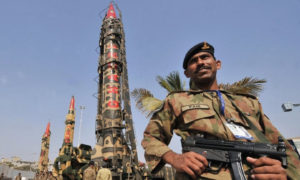By: Muhammad Abbas Hassan
Pakistani Nuclear program has been under global focus; unfortunately, the focus has always been determined by a subjective understanding of the program than an objective analysis. The key determinants of the Pakistani nuclear program are the energy and security needs of the country. It is the result of efforts put in by individuals and their dedication that has turned Pakistan into a nuclear power. The Pakistani nuclear program picked up speed after India cheated the world through the detonation of the smiling Buddha. It should be noted here that the inception of Nuclear Suppliers Group (NSG) previously known as the London Supplier Group was a direct result of Indian actions.
The Pakistani program which was started to protect the country from external aggression has always been and will always remain in the limelight. Due to the geographical location of Pakistan, its nuclear program has been under severe criticism, and the country also had to face some sanctions. Despite all the pressures and imposed sanctions, Pakistan tested its capability in response to the Indian testing in May 1998.
Pakistan had to become a nuclear state not by choice but by compulsion of situations due to growing conventional asymmetry and its threat perception vis-à-vis India who, by its admission, fueled and actively supported an engineered insurgency for Pakistan’s break up in 1971. India, being many times bigger in size and conventional military might which spends ten times more on its military initiatives persistently poses a direct threat to Pakistan, while working closely with Pakistan’s internal and external enemies to destabilize the country. The latest Kulbhushan Yadav fiasco is a prime example of Indian interference in Pakistan.
Since the detonation of Pakistan’s first nuclear weapon, Pakistan defined its nuclear threshold and stated that it would not use its nuclear devices unless India provokes it to do so. Pakistan also vowed to maintain its capability as a minimum credible deterrence to counter security threats from India. However, since 1998 there have been some developments, and especially after India’s incessantly provoking actions and its‟ military wing introducing strategies like Cold Start Doctrine (CSD), Pakistan was left with no option but to make adjustments in its nuclear doctrine and take a stance deemed more adequate to maintain deterrence.
Pakistani policy-makers argue that the deterrent value of their current arsenal operates only at the strategic level. The gap at the strategic level gives the enemy the freedom to successfully initiate Cold Start-style military operations against Pakistan, without the fear of nuclear escalation.
With these developments, it was becoming increasingly impossible for Pakistan to maintain its original doctrine without making adjustments. Pakistan, therefore, developed low yield, short-range, tactical battlefield nuclear weapon, the Nasr missile which provides “flexible deterrence options” for an appropriate response to Cold Start, rather than massive nuclear retaliation against India.
Pakistan’s Full Spectrum Deterrence is a “qualitative” response to new war fighting concepts introduced by India, (i.e. Cold Start and Pro Active Operations), and tactical nuclear weapons like Nasr gives more flexibility to Pakistani decision-makers to deal with conventional threats from India. According to Pakistan’s narrative, tactical nuclear weapons are to balance the conventional advantage of India, but India perceives it to be a destabilizing factor in the region.
Many other countries follow the same course to defend their land and interests, as Israel adheres to its “strategic depth” doctrine and considers preemptive measures to be an effective method because they don’t have enough space to retreat in case of any aggression. Same is the case of Pakistan, as it cannot adopt the defensive tactics like ‘deep defense’ because its main cities are almost at the international border.
It should also be kept in mind that Pakistan has made some efforts to keep South Asia denuclearized. All of these proposals were rejected by India. In 1978, India rejected the Pakistani proposal of South Asian Nuclear Weapon free zone. In 1979, India rejected some proposals that included:
- Proposal for mutual inspection of each other’s nuclear facilities
- Simultaneous adherence to NPT
- Simultaneous acceptance of full-scope IAEA safeguards
In 1987, India also rejected the proposal of bilateral nuclear test ban treaty and refused a proposed South Asia Zero Missile Zone in 1994.
The Pakistani actions highlight that it has always acted as a responsible state and has made tireless efforts to maintain peace in the region. It was the actions of India that nuclearized sub-continent, and despite the attempts made by Pakistan, India continued with its actions and plans.
However, the discriminative Western policy of being lenient towards India and giving special treatment to the country, while criticizing Pakistan’s stance and its nuclear policies could lead to further escalation of tensions in the South Asian region.

